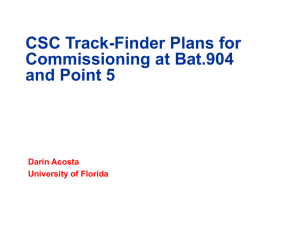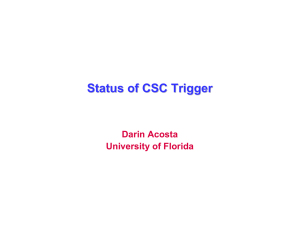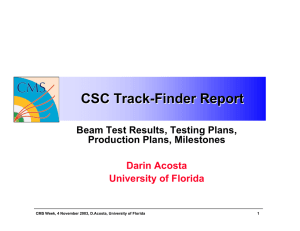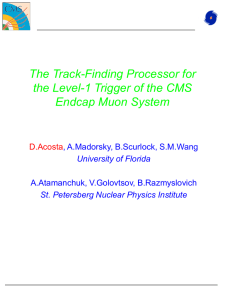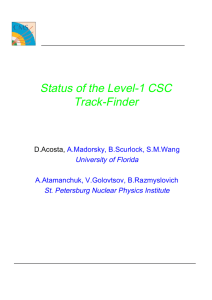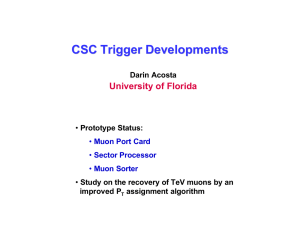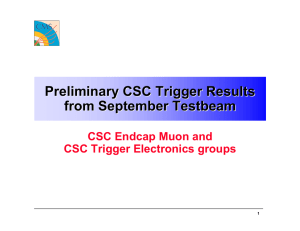Status of the CSC Track-Finder University of Florida Darin Acosta
advertisement
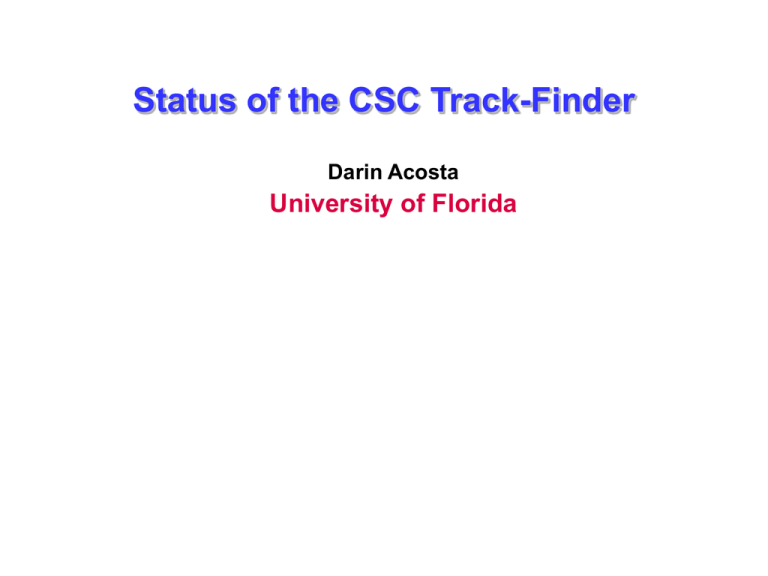
Status of the CSC Track-Finder Darin Acosta University of Florida CSC Muon Trigger Scheme TriDAS part: Second generation prototypes EMU part: mostly in production Muon Portcard (1) Trigger Motherboard (9) Clock Control Board Trigger Timing & Control D T D TD T D T D T CMT DT D T D T D M M M MM M M M M M C P M MM M M MM M C BB B BB BB B B B B CB BB B B BB B O N T R O L L E R Optical link Muon Sorter (1) Sector Processor (12) CFEB CFEB CFEB CFEB CFEB CSC Track-Finder Crate (1) In underground counting room 3-D Track-Finding and Measurement CMS Week, 25 Feb 2003 DAQ Motherboard (9) LVDB ALCT Peripheral Crate on iron disk (1 of 48) Cathode Front-end Board Anode LCT Board On detector Trigger Primitives 2 CSC Anode Front-end Board D.Acosta, University of Florida 1st Prototype Track-Finder Tests (2000) Sector Processor (Florida) Sector Receiver Clock Control (UCLA) Board (Rice) Bit3 VME Interface Very successful, but overall CSC latency was too high -New 2002 design improves latency Custom ChannelLink Backplane (Florida) Results included in Trigger L1 TDR CMS Week, 25 Feb 2003 Muon Port Card (Rice) 3 D.Acosta, University of Florida CSC Track-Finder Crate Muon Sorter SR SR SR SR SR SR / / / / / / SP SP SP SP SP SP MS CCB Clock and Control Board SBS 620 Controller Second generation prototypes SR SR SR SR SR SR / / / / / / SP SP SP SP SP SP Sector Processor From MPC (chamber 4) From MPC (chamber 3) From MPC (chamber 2) From MPC (chamber 1B) 4 merged boards From MPC (chamber 1A) To DAQ Single Track-Finder Crate Design with 1.6 Gbit/s optical links CMS Week, 25 Feb 2003 4 D.Acosta, University of Florida Combined SR/SP 2002 Prototype Problems encountered attempting layout using in-house tools Sent to industry for completion of layout using Cadence Allegro Final board takes 16 layers Cost of manufacture, assembly, and parts is about $20K / board CMS Week, 25 Feb 2003 5 D.Acosta, University of Florida SP2002 Main Board (SR Logic) DC-DC Converter EEPROM Phi Global LUT VME/ CCB FPGA Eta Global LUT Phi Local LUT TLK2501 Transceiver Front FPGA Optical Transceivers •15 x 1.6 Gbit/s Links 3 SRs CMS Week, 25 Feb 2003 6 D.Acosta, University of Florida SP Trigger Logic From SP2000 to SP2002 mezzanine card Xilinx Virtex-2 XC2V4000 ~800 user I/O (Mezzanine card also used for CSC sorter) CMS Week, 25 Feb 2003 7 D.Acosta, University of Florida Tests underway… CMS Week, 25 Feb 2003 8 D.Acosta, University of Florida Optical Link Test Results Using pseudo-random test built into TLK2501 chipset SP02 optical loopback test over 1 m optical cable No errors! SP02 optical loopback test over 100 m cable BER = 1012 MPCSP02 optical test over 100 m cable BER = 3×1013 Controlled MPCSP02 chain test Download 255 bx of data for one MPC (3 muons × 32 bits), preceding each iteration with a L1 Reset Send data over three 100 m cables into SP, and readout Counting the 0’s transmitted between iterations, 30 link errors observed in total from 3 links over 16 hours (3×1014 bits) BER = 1013 Thus, about 1 error / hour, likely from clock jitter CMS Week, 25 Feb 2003 9 D.Acosta, University of Florida Optical Link Tests (Cont’d) Controlled MPCSP02 chain test without L1 Reset This is how we would like to operate Explicitly check data sent vs. data received Tests underway, code still needs improvements (e.g. to issue L1 Reset if link fails and does not recover) CMS Week, 25 Feb 2003 10 D.Acosta, University of Florida Schedule Proposed schedule as of Feb-2003: Feb.’03: SP02 prototype completed, initial tests begin √ Mar.’03: MPCSP optical link tests √ (April) Apr.’03: SP memory and trigger logic tests May.’03: CSC system tests with cosmic rays and beam tests at CERN June ’03… : Tests with Muon Sorter and DT Track-Finder CMS Week, 25 Feb 2003 11 D.Acosta, University of Florida Test Beam Plans Plan to test CSC Trigger all the way to the Track-Finder in May/June beam tests Complete chain test from 2 detectors to peripheral crate electronics to Track-Finder crate electronics! Structured beam period: 23 May 1 June Two DAQ systems will run concurrently: CSC DAQ and Track-Finder DAQ Track-Finder will just log inputs, not generate a track trigger Goal is to validate trigger primitives are found efficiently on correct bx and successfully received over optical links Record as much data as possible under various detector configurations for future track identification studies Asynchronous beam period: 13 June 1 July Possibility to test a unified DAQ using “slice test” software developed in XDAQ CMS Week, 25 Feb 2003 12 D.Acosta, University of Florida Conclusions Second generation CSC Track-Finder prototype completed Optical link tests between Port Card and Sector Receiver successful Measurable (but small ~10-13) bit error rate seen Plan to take T-F to beam test later this month Tests of SR memories and SP trigger logic to follow Interface tests with CSC Sorter and DT T-F also planned CMS Week, 25 Feb 2003 13 D.Acosta, University of Florida
